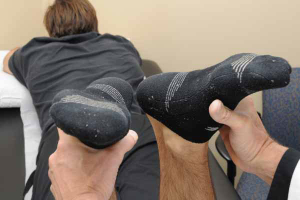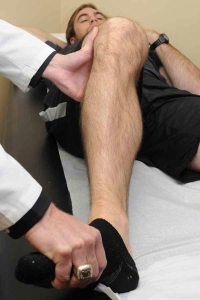As indicated for the dial test at 30°, the dial test at 90° is also performed to determine the amount of external rotation of the tibia which occurs on the femur. A positive dial test at 90° usually indicates a combined posterolateral corner and cruciate ligament injury, but it may also indicate a severe medial knee injury (isolated or combined). Thus, it is important to determine the amount of posterolateral or anteromedial rotation of the tibia which occurs in the femur. Thus, the dial test at 90° should be performed both supine and prone.
The dial test at 90° of knee flexion in the supine position is performed with the knee flexed at 90°, the femur stabilized and an external rotation force applied to the tibia through the foot and ankle. The amount of increased external rotation which occurs compared to the contralateral side should be assessed. The dial test at 90° in the prone position is performed with the patient lying on their stomach with their knees together. The difference in external rotation between the feet is then assessed.


